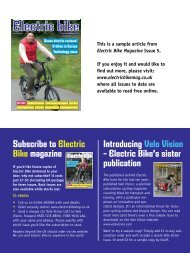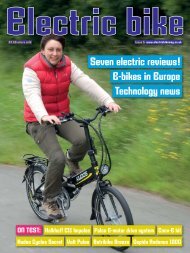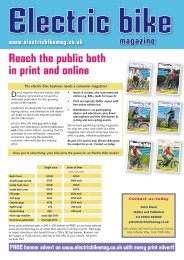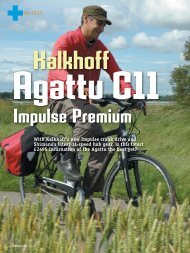Issue Six - Spring 2013 - Electric Bike Magazine
Issue Six - Spring 2013 - Electric Bike Magazine
Issue Six - Spring 2013 - Electric Bike Magazine
Create successful ePaper yourself
Turn your PDF publications into a flip-book with our unique Google optimized e-Paper software.
+E-BIKE BASICS<br />
ELECTRIC BIKE BEGINNER GUIDEI<br />
More types: motors<br />
As well as the main distinction<br />
between torque sensing and<br />
rotation sensing, it’s also<br />
useful to know about the two<br />
main motor types.<br />
Second<br />
You really should test ride the two<br />
basic types of electric bike:<br />
A bike with ‘torque sensing’<br />
control. This means that rather like<br />
power steering on a car, the electric<br />
assistance amplifies any effort you<br />
put into the pedals, making you feel<br />
like you have superhuman legs. This<br />
type feels just like a normal bike, but<br />
with a tailwind. You do need to be<br />
putting some effort (which generates<br />
torque, which the sensor measures)<br />
through the pedals, though, before<br />
you’ll get any assistance from the<br />
motor. So you can’t just sit there and<br />
let the motor pull you along: instead<br />
you’re definitely going to be getting<br />
some exercise, but without the strain.<br />
Often favoured by people who have<br />
done a fair bit of unassisted cycling,<br />
or those looking for fitness benefits<br />
from their electric ride. Prices start<br />
around the £1000 mark, however.<br />
A bike with ‘rotation sensor’<br />
control. This means that the motor,<br />
when it kicks in, does so at a set<br />
level, and it continues until you stop<br />
pedalling or squeeze the brakes. It’s<br />
the rotation of the pedals which<br />
controls when the motor operates.<br />
You don’t have to be actually putting<br />
an effort into pedalling, you can just<br />
be waving them round. Many of these<br />
bikes also have a throttle, so you can<br />
just sit there and be pulled along,<br />
ideal as a ‘get me home’ mode if you<br />
run out of puff. You can pedal too,<br />
of course, and get quite a workout,<br />
especially if the motor assist is set at<br />
a low level – but this can take a little<br />
discipline! This type of machine is<br />
available at all price points.<br />
This is the key distinction in how<br />
bikes operate, and the ride sensation<br />
is so different between the two that<br />
I really would recommend trying<br />
both. If not, and you don’t try the<br />
type which grabs you, you’ll be really<br />
missing out.<br />
It’s always puzzled me, incidentally,<br />
why no manufacturer has a model<br />
which offers both modes, so the user<br />
could switch between them. Maybe<br />
next year?<br />
PHOTO: Batribike<br />
Geared motors are used in<br />
most hub motors and all (I’m<br />
fairly sure) crank drives. A<br />
fast-spinning motor (usually the<br />
‘brushless DC’ type) is geared<br />
down within the hub or drive unit<br />
so that the output matches the<br />
speed of the wheels or cranks.<br />
This helps the motor operate at<br />
an efficient speed, and the motor<br />
can be smaller, too.<br />
The downside is that there’s<br />
inevitably some noise from<br />
the meshing of the gear teeth.<br />
Hubs are usually more noisy<br />
than crank drives, but in recent<br />
models the noise level is really<br />
pretty low for both.<br />
Gears can, of course, wear<br />
out, but this doesn’t seem to<br />
be much of an issue in modern<br />
drives. Good ones are well sealed<br />
and the gears run in internal oil<br />
baths or long lasting grease.<br />
Direct drive motors don’t<br />
have any gears involved at all.<br />
There’s a ring of magnets inside<br />
the hub shell, and a ring of<br />
coils attached to the axle, with<br />
just a small air gap between<br />
them. As the coils are energised<br />
they pull the magnets round.<br />
There’s no physical contact<br />
and so these drives tend to be<br />
completely silent.<br />
One possible drawback is that<br />
at very low speeds they can have<br />
limited power, although modern<br />
control systems are getting<br />
ever better in this respect. They<br />
also tend to require large hubs,<br />
which can be problematic when<br />
building small wheels, and have<br />
typically been a little heavier<br />
than geared hubs (but again<br />
development is reducing the<br />
weight). Finally, they tend to be<br />
at the higher end of prices.<br />
Examples include systems from<br />
BionX, Falco, Storck-Raddar, BH<br />
Emotion ‘Neo’ and others.<br />
36 <strong>Electric</strong> <strong>Bike</strong> <strong>Issue</strong> 6












